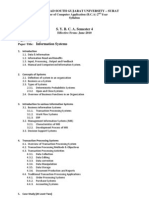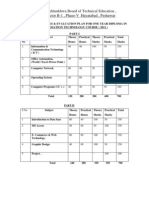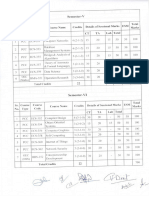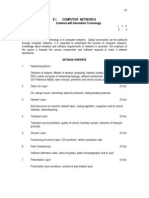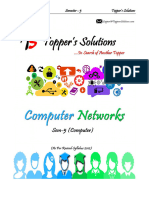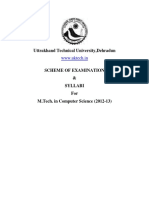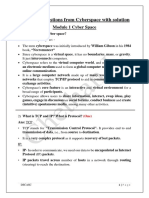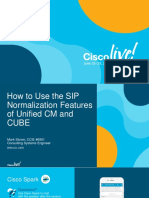Swami Ramanand Teerth Marathwada University, Nanded: RD TH
Swami Ramanand Teerth Marathwada University, Nanded: RD TH
Uploaded by
SUShantpimpleCopyright:
Available Formats
Swami Ramanand Teerth Marathwada University, Nanded: RD TH
Swami Ramanand Teerth Marathwada University, Nanded: RD TH
Uploaded by
SUShantpimpleOriginal Title
Copyright
Available Formats
Share this document
Did you find this document useful?
Is this content inappropriate?
Copyright:
Available Formats
Swami Ramanand Teerth Marathwada University, Nanded: RD TH
Swami Ramanand Teerth Marathwada University, Nanded: RD TH
Uploaded by
SUShantpimpleCopyright:
Available Formats
Swami Ramanand Teerth Marathwada University, Nanded
M.Sc. (Information Technology) revised syllabus (With effects from 2012-13) M.Sc. (Information Technology) Second Year Third Semester: Paper Code
Subject
Lectures/ Week
Max. Practical Total Exam Marks Marks Marks Duration Theory(A) (B) (A+B) 100 100 100 100 100 100 100 100 03 hrs 03 hrs 03 hrs 03 hrs 03 hrs 03 hrs
M.Sc.(IT).S3.1
Software Engineering M.Sc.(IT).S3.2 Computer Networks M.Sc.(IT).S3.3 VB.Net M.Sc.(IT).S3.4 RDBMS through Oracle 10G M.Sc.(IT).S3.PR1 VB.Net M.Sc.(IT).S3.PR2 Oracle 10 G
Theory Practical 4 100 4 4 4 3 3 100 100 100
Total Fourth Semester M.Sc.(IT).S4.1 Java Programming M.Sc.(IT).S4.2 Software Testing M.Sc.(IT).S4.3 Web Development & PHP programming M.Sc.(IT).S4.4 Seminar on Project Work. M.Sc.(IT).S4.PR1 Java Programming M.Sc.(IT).S4.PR2 Soft Testing + MySQL and PHP
600
4 4 4 4 3 3
100 100 100 100 100 100
100 100 100 100 100 100
03 hrs 03 hrs 03 hrs 03 hrs 03 hrs 03 hrs
Total 3rd and 4th Semester
600 1200
M.Sc.(IT).S3.1 - Software Engineering. (100 MARKS) (Total Lectures 50) 1. The Product: The Evolving Role Of Software Software: Software Characteristics Software Applications Software Crisis & Horizon Software Myths 2. Process Of Software Software Engineering Software Process Software Process Model Linear Sequential Model Prototyping Model Evolutionary Process Model Spiral Model 3. Management Concepts Management Spectrum The People: The Product The Process The Project People: Layers Leaders & Software Team 4. Software Process & Project Metrics Measures, Metrics & Indication Metrics In The Process & Project Domains Software Measurement Metrics For Software Quality 5. Software Project Planning Observation Estimation Project Planning Objectives Software Scope Resources Software Project Estimation 6. Risk Analysis & Management Software Risks Risk Identification Risk Projection 7. Quality Assurances Quality Concepts Software Quality Assurance Formal Technical Reviews 8. Testing Techniques Software Testing Fundamentals White Box Testing Black Box Testing 9. Software Testing Strategies A Strategic Approach To Software Testing Unit Testing Integration Testing Top-Down Integration Bottom Up Integration
Reference Books: 1. SOFTWARE ENGINEERING (A PRACTITIONERS APPROACH) BY ROGERS PRESSMAN (FIFTH EDITION) 2. SOFTWARE ENGINEERING (A PRACTITIONERS APPROACH) BY ROGERS PRESSMAN (FOURTH EDITION)
M.Sc.(IT).S3.2 Computer Networks
1 Introduction to Computer Networks (Lectures: 7) Computer Networks, goals and applications Network Hardware broadcast and point-to-point, topologies star, bus, mesh, ring etc. Network Types LAN, MAN, WAN, Wireless Networks, Home Networks, Internetworks, Protocols and Standards Definition of Protocol, Defacto and Dejure standard Peer to-peer and Server based LAN Network Software Protocol Hierarchies -layers, protocols, peers, interfaces network architecture, protocol stack design issues of the layers addressing, error control, flow control, multiplexing and demultiplexing ,routing Connection-oriented and connectionless service Service Primitives listen, connect, receive, send, disconnect and Berkley Socket The relationships of services to protocol 2 Network Models (Lectures: 5) OSI Reference Model Functionality of each layer TCP/IP Reference Model Introduction to IP, TCP, and UDP TCP/IP Protocol Suite Comparison of OSI and TCP/IP model Addressing Physical, Logical and Port addresses 3 The Physical Layer (Lectures: 10) Basic Concepts Signals, Types Analog and Digital Signals, Bit rate, bit length, baseband transmission Transmission Impairnments attenuation, distortion and noise Data Rate Limits Nyquists bit rate formula for noiseless channel and Shannons law Performance of the Network Bandwidth, Throughput, Latency(Delay), Bandwidth Delay Product, Jitter Line Coding Characteristics, Line Coding Schemes Unipolar, NRZ, RZ, Manchester and Differential Manchester Transmission Modes-Parallel Transmission Serial Transmission Asynchrounous and Synchrouous Multiplexing FDM and TDM Switching Circuit Switching, Message Switching and Packet Switching ISDN Services, Evolution, Architecture 4 The Data Link Layer (Lectures:12) Design Issues Services to Network Layer, Flow Control, Error Control Framing Character Count, Byte Stuffing, Bit Stuffing and Physical Layer Coding Violations Error Control Hamming Code and CRC Elementary Data Link Layer Protocols Utopia, A Simplex Stop-And-Wait, A Simplex protocol for noisy channel Sliding Window Protocols PiggybackingNeed,Advantages/Disadvantages, 1-bit sliding window protocols, Pipelining Go-Back N and Selective Repeat Data Link Layer Protocols HDLC frame format, all frame types PPP Use, Frame Format, Use of PPP in the Internet
5 The Medium Access Sublayer (Lectures:7) Random Access Protocols ALOHA pure and slotted CSMA 1-persistent, p-persistent and non-persistent CSMA/CD CSMA/CA Controlled Access Reservation, Polling and Token Passing Channelization FDMA, TDMA and CDMA-Analogy, Idea,Chips, Data Representation, Encoding and Decoding, Signal Level, Sequence Generation 6 Wired LANS (Lectures:7) IEEE Standards Data Link Layer, Physical Layer 1 Standard Ethernet MAC Sublayer Frame Format, Frame Length, Addressing, Access Method Physical Layer Encoding and Decoding, 10Base5, 10Base2, 10BaseT, 10Base-F, Changes In The Standard Bridged Ethernet, Switched Ethernet, Full Duplex Ethernet Fast Ethernet Goals, MAC Sublayer, Topology, Implementation Gigabit Ethernet goals, MAC Sublayer, Topology, Implementation Ten-Gigabit Ethernet goals, MAC Sublayer, Physical Layer Reference Books: 1) Computer Networks by Andrew Tanenbaum, Pearson Education. 2) Data Communication and Networking by Behrouz Forouzan, TATA McGraw Hill.
M.Sc.(IT).S3.3 Visual Basic.Net
1. Getting Started With VB.Net 1.1 The integrated Development Environment 1.2 The Start Page 1.3 Project types 1.4 The IDE Components 1.4 Building Console Application 2. Visual Basic: The Language 2.1 Variables 2.2 Constants 2.3 Arrays 2.4 Flow Control Statements 3. Writing And using procedure 3 1 Subroutine 3.2 Function 3.3 Arguments passing Mechanisms 3.4 Event handler Arguments 3.5 Passing an unknown number of Arguments 3.6 Overloading function 4. Working with Forms 4.1 The Appearance of the Form 4.2 Properties of the form 4.3 Anchoring & Docking 4.4 The Form Events 4.5 Loading & Showing Forms 4.6 Controlling one Form from within another 4.7 Forms vs. Dialog Boxes 4.8 Designing Menus 4.8.1 The Menu Editor 4.8.2 The Menu item Object Properties 4.8.3 Manipulating menus Run Times 4.8.4 Iterating a menu Item 4.9 Building Dynamic Form at Run Time 4.9.l Creating Event handler At Run Time 5. Basic and More Windows Controls 5 .1 The Text Box. Control 5.1.1 Basic Properties 5.1.2 Text manipulation properties 5.1.3 Text selection properties 5.1.4 Text Selection Method 5.1.5 Undoing Edits 5.1.6 Capturing keystrokes 5.2 The ListBox, CheckedListBox, & ComboBox Control 5.2.1 Basic properties 5.2.2 The Item Collection 5 2.3 Searching 5.3 The Scrollbar & Trackbar Control 5.4 The Common Dialog Control 5.4.1 Color Dialog Box 5.4.2 The font Dialog Box 5.4.3 The Open & save As Dialog Box 5.4.4 The Prim Dialog Box 5.5 The Rich Text Control 5.5.1 The Rich textbox Properties 5.5.2 Methods 5.5.3 Advanced Edition Feature
5.5.4 Cutting & Pasting 5.5.5 Searching in Rich Textbox 5.5.6 Formatting URL 5.6 Print Documents, PrintDialog, PageSetupDialog, PrintPreviewDialog Controls printer & Page Properties 5.7 ImageList Control 5.8 The TreeView Control 5.8.1 Adding new Items at Design Time 5.8.2 Adding New Item at Run time 5.8.3 Assigning images to Node 5.8.4 Scanning the Tree View Control 5.9 The ListView Control 5.9.1 The Column Collection 5.9.2 The ListItem Objects 5.9.3 The Item Collection 5.9.4 The Sub Item Collection 6. Building Custom Class & Windows Control 6.1 Building & using Custom class 6.2 Properties in custom class 6.3 Inheritance 6.4 Polymorphism 6.5 MyBase & MyClass Keywords 6.6 Building & using Custom Control 6.7 designing Irregular Shaped Control 6.8 Deigning Owner Drawn Menus 7. Handling Strings, Charters& Dates 7.1 The Char & String Class 7.2 The DateTime Class 8. Working with Files & Folders 5.1 Directory, File, Directory Info, fileInfo & Path Classes 5.2 File Stream, StreamReader, Stream Writer Objects S.J Sending Data to a File 8.4 The File System watcher Components 9 Drawing & Painting with Visual Basic 9.1 Displaying linage 9.2 Exchanging Images through the clipboard 9.3 Drawing with GDI+ 9.4 The Basic Drawing Objects 9.5 Drawing Shapes 9.6 Drawing Methods 10. Error Handling & Debugging 10.1 Types of Error 10.2 Exception & Structured Exception handling 10.3 Debugging 11. Tilt Multiple Documents Interface 11.l MDl Application 11.1.1 Building MDl Application 1 1. 2 Built In capabilities of MDl Application 1 1.3 Accessing Child Forms 12. Building Database Application with ADO.NET 12.1 The ARCHITECTURE of ADO.NET 12.2 Creating Dataset 12.2.1 DataGrid Control. 12.5 Data binding 12.4 DataAdapter Object 12.5 The Command & DataReader Objects 12.0 The Structure of Dataset 12.7 The DataForm Wizard
12.8 Transactions
Reference Books
1. Mastering Visual Basic.Net By Evangelos Patroutsos (BPB Publication) 2. Visual Basic. Net Programming By Billy Hollis, Rockford Thotlog (Wrox Publication) 3. Visual Basic.Net Programming Black Book By Steven Holzner 4. Beginning VB.Net (2nd Edition)
M.Sc.(IT).S3.4 Oracle 10G SQL & PL/SQL 1. Introduction and Basic Concepts DBMS 1.1 Structure of DBMS 1.2 Advantages & Disadvantages 1.3 Users of DBMS 1.4 Database Models Hierarchical Data Model Network Data Model Relational Data Model E R Data Model 2. SQL Statements &Working with tables 2.1 DDL 2.2 DML Procedural DML Non Procedural DML 2.3 DQL 2.4 DCL 2.5 Transaction Control Commands 2.6 Data types in SQL 2.7 Creating & Managing Tables 2.8 Manipulating Data 2.9 Retrieving data using SELEC T Command 2.10 WHERE Clause 2.11 DISTINCT Clause 2.12 Using Column Aliases 2.13 Working with Views Creating View on Tables Creating View on Views Updating Views Altering Views 3. Sorting & grouping Data in SQL 3.1 Using Order By Clause 3.2 Using Group By & Having clause 3.3 Substitution Variables 3.4 Using &, && 3.5 Using DEFINE 3.6 Using VERIFY 4. SQL Functions 4.1 Single Row Functions Character Functions Case Manipulation Character Manipulation Number Functions Date Functions ConversionFunctions GeneralFunctions 4.2 Multiple Row Functions 5. Using Operators 5.1 Using Comparison Operators BETWEEN IN LIKE 5 Hrs.
8 Hrs.
5 Hrs.
6 Hrs.
6 Hrs.
IS NULL 5.2 Logical Operators AND OR NOT 6. Joining Tables&Working with Sub queries 6.1 What is Join? 6.2 Natural Join/Inner Join/Equijoin 6.3 Joining With USING Clause 6.4 Joining With ON Clause 6.5 Self Join 6.6 Cross Join/ Cartesian Product 6.7 Outer Join Left Outer Join Right Outer Join Full Outer Join 6.8 What is Sub query? 6.9 Single Row Sub query 6.10 Multiple Row Sub query 7. Security 7.1 Creating User 7.2 Privileges System Level Privileges Object Level Privileges 7.3 Granting Privileges 7.4 Revoking Privileges 7.5 Roles Study of default roles Creating roles 7.6 Granting and Revoking roles 8. PL/SQL 8.1 An Introduction to PL/SQL 8.2 PL/SQL Overview 8.3 Declaration section 8.4 Executable Commands section 8.5 Condition logic 8.6 Loops 8.7 Exception Handlings 8.8 Triggers Triggers Syntax Types of triggers Enabling and Disabling Triggers Replacing and Dropping Triggers 8.9 Working Cursor % TYPE Variable % ROWTYPE Variable Reference Books -
6 Hrs.
6 Hrs.
7 Hrs.
1. Oracle Database 10g SQL (Osborne ORACLE Press Series)by Jason price, McGrawHill, 007-222981-0. 2. Oracle Database 10g PL/SQL Programming by Scott Urman , Ron HARDMAN, MichaleMc Laughlin, Oracle Press, TMH, ISBN-0-07-059779-0. 3. Oracle Database 10g The Complete Reference By Kevin Loney, Bob Bryla Oracle Press (TATA McGraw Hill Edition) ISBN-13:978-0-07-059425-8, ISBN-10: 0-07-059425-2
Lab Assignments: M.Sc.(IT).S3.PR1- VB.Net (100 Marks) 1. Building Console Application 2. Building Math Calculator 3. Programme using Arrays 4. Program using Control Structure 5. Programme using Loop Structure 6. Programme using Subroutines, & Functions 7. Programme for Demonstration of various Controls 8. Programme for Demonstration of Common Dialog Controls 9. Building Notepad 10. Programme using polymorphism, Inheritance 11. Building Customs Classes & Control 12. Programme using exception Handling 13. Programme using MDI Application 14. Programme using Database handling 15. Building Web Application M.Sc.(IT).S3.PR2- Oracle 10G (100 Marks) Should cover at least 25 assignments based on its theory syllabi.
M.Sc.(IT).S4.1 Java Programming
1. Introduction Introduction to Java - Features of Java - Object oriented concepts - Data types - Variables - Arrays Operators - Control statements 2. Basics of Java Classes - Objects - Constructors - Overloading method - Access control - Static and final methods Inner Classes - Inheritance - Overriding methods - Using super abstract class-- String classString objects - String buffer - Char Array 3. Packages and Interfaces Packages , Access protection , Importing packages, Interfaces 4. Exception Handling Exception-Handling fundamentals, Exception types, uncaught exceptions, using try and catch, Multiple catch clauses, Nested try statements, throw, throws, finally, Javas Built in Exceptions 5. Applets Applet basics, Applet architecture, applet skeleton, simple applet display methods, Requesting repainting, Using the status window, the Html APPLET Tag, get Document Base and get Code Base 6. Input/Output &Networking Networking Basics, Java and the Net, Inet Address, TCP/IP client sockets, url connection, TCP/IP server sockets, Datagram 7. Multithreaded programming The Java Thread Model, Thread priorities, synchronization, messaging, the thread class and run able interface, creating a thread, creating multiple threads, thread priorities, suspending resuming and stopping threads 8.Using Awt, Layout managers and menus Control fundamentals ,labels, Using Buttons ,Applying check boxes, checkbox group, choice controls, Using Lists, Managing scrollbars, Using a Text field, Using a Text area ,Understanding Layout Managers TEXT BOOKS .Naughton and H.Schildt - "Java 2 - The complete reference" - Fourth edition.-2002 S.Horstmann, Gary Cornell - "Core Java 2 Volume I - Fundamentals" - Addison Wesley 2001 Arnold and J.Gosling - "The java programming language" - Second edition Art Gittleman Ultimate Java Programming Wiley Publications-2002
M.Sc.(IT).S4.2 Software Testing
1. Introduction to Software Testing 8 Hrs 1.1 Quality, Quality Culture, Customer View 1.2 Characteristic of Software, SDLC Life cycle 1.3 Definition of Software testing, Principles of Software testing 1.4 Economics of testing, Testing policy 1.5 Structure d approach to testing. Testing Process, Test objects 1.6 Test Methods, Black Box testing, White box testing 1.7 Configuration Management 2. Defect Management 8 Hrs 2.1 Defect, Software Verification and Validation 2.2 Defect Techniques for Finding defect, Static technique 2.3 Dynamic technique, Categories of testing, Defect Management Process 2.4 Defect Management Risks, Retesting, Defect Life Cycle 2.5 Defect Tracking Tools, Severity, Priority 2.6 Defect Reporting, Defect Density 3. Levels of Testing 7 Hrs 3.1 V Model, Stub, Driver, Integration Testing 3.2 Bottom-Up Testing, Top-down testing Sub-System testing 3.3 System testing, Execution Testing, Usability Testing 3.4 Compatibility testing, Operation testing, Acceptance Testing 3.5 Alpha Testing, Beta Testing. Tegression testing Error-handling testing 3.6 Manual-Support testing, Smoke testing, Ad-hoc testing 3.7 Parallel Testing, Stress testing, Load testing. 4. Writing and Tracking Test Cases 8 Hrs 4.1 Test plan, Test plan Benefits, Test Plan Template, Test Scope 4.2 Test Objectives, Assumptions, Risk, Risk Analysis 4.3 Risk management, Test Schedule and Planned Resources 4.4 Test case planning overview, Test Design, Test Cases, Test Procedures 4.5 Building Test Data, Equivalence Partitioning, Boundary Value analysis 4.6 Test case Organization and Tracking 5. Automated Testing and Test Tools 10 Hrs 5.1 Benefits of Automation, Introduction to Winrunner7.01 5.2 Recording and Playback, GUI Map File and GUI map per Test 5.3 Creating Checkpoints, Virtual Object wizard, Programmed macros 5.4 Recording Tests, Synchronizing Test, checking bitmaps 5.5 Creating Data Driven Tests, Reading Text, Creating Batch Tests. 6. Test Director Software 4 Hrs 6.1 Server and Client System configuration, Applications of Test Director 6.2 Creating Users in the project, Assigning Rights 6.3 Writing Test Cases in Test Director, Automation of test cases 6.4 Bug reporting, Customization of Fields 7. Quick Test Professional 7 Hrs 7.1 Introduction to QTP, Record and Play back, Active Screen 7.2 Running and analyzing Tests, Creating Checkpoints 7.3 Parameterizing Tests, Creating Output Values 7.4 Working with regular Expression, Dividing Tests into Multiple Actions Reference Books:1. Software Engineering by Roger S. Pressman, McGraw Hill International Pub. 2. Software Testing in the Real World by Edward Kit, Addition Wesley Pub. 3. Software Testing by Ron Patton, BPB Publication 4. The Art of Software Testing by G. J. Myers, Wiley-InterScience Pub.
M.Sc.(IT).S4.3 Web Development and PHP Programming
1. Introduction to web techniques 8 HTTP basics, Introduction to Web server and Web browser Introduction to PHP What does PHP do? Lexical structure Language basics 2. Function and String 10 Defining and calling a function Default parameters Variable parameters, Missing parameters Variable function, Anonymous function Types of strings in PHP Printing functions Encoding and escaping Comparing strings Manipulating and searching strings Regular expressions 3. Arrays 6 Indexed Vs Associative arrays Identifying elements of an array Storing data in arrays Multidimensional arrays Extracting multiple values Converting between arrays and variables Traversing arrays Sorting Action on entire arrays Using arrays 4. Introduction to Object Oriented Programming 8 Classes Objects Introspection Serialization Inheritance Interfaces Encapsulation 5. Files and directories 6 Working with files and directories Opening and Closing, Getting information about file, Read/write to file, Splitting name and path from file, Rename and delete files Reading and writing characters in file Reading entire file Random access to file data Getting information on file Ownership and permissions 6. Web Techniques 10 Variables Server information Processing forms Setting response headers Maintaining state, SSL
References 1. Programming PHP Rasmus Lerdorf and Kevin Tatroe O'Reilly publication 2. Beginning PHP 5 Wrox publication 3. PHP web sevices Wrox publication 4. AJAX Black Book Kogent solution 5. Mastering PHP BPB Publication 6. PHP cookbook O'Reilly publication 7. Learning PHP and MYSQL O'Reilly publication 8. PHP and MYSQL O'Reilly publication 9. PHP for Beginners SPD publication 10. www.php.net.in 11. www.W3schools.com 12 www.wrox.com
Lab Assignments: M.Sc.(IT).S4.PR1- Java Programming (100 Marks) At least 25 programs should cover based on its theory syllabi M.Sc.(IT).S4.PR2 (100 Marks) Software Testing (50 Marks) 1. To study what is Software Testing. 2. To study verification method 3. To study validation method 4. To study Defect Management Process 5. To study Defect Life Cycle. 6. To study introduction to Winrunner 7. To study Synchronization in Winrunner. 8. To study Checkpoints in Winrunner. 9. To study to study Data Driver Wizard and Virtual Object Wizard 10. To study Batch File Mode in Winrunner 11. To study introduction to QTP 12. To study Synchronization in QTP 13. To study Checkpoints in QTP 14. To study Data Driven Testing (Parameterization) in QTP 15. To study Working with Regular Expression 16. To study Dividing Test into Multiple Actions. 17. To study Test Director. Web Development & PHP Programming (50 Marks) At least 15 assignments should cover through PHP.
You might also like
- Functional Design and ArchitectureDocument216 pagesFunctional Design and ArchitectureAsher Horowitz100% (2)
- Python For Everybody: Exploring Data Using Python 3Document245 pagesPython For Everybody: Exploring Data Using Python 3Nurul Hana100% (1)
- CISM Acronyms PDFDocument4 pagesCISM Acronyms PDFComas OlivosNo ratings yet
- Computer Networking: A Top-Down Approach, 8 Edition: Table of Contents Chapter 1 Computer Networks and The InternetDocument6 pagesComputer Networking: A Top-Down Approach, 8 Edition: Table of Contents Chapter 1 Computer Networks and The Internetvignesh siva0% (1)
- 01 - CVP Comprehensive Call FlowsDocument49 pages01 - CVP Comprehensive Call Flowsashwinsiemens100% (2)
- Sage CRM Developer GuideDocument307 pagesSage CRM Developer GuidesunitacrmNo ratings yet
- Internet Technology and Web DesignDocument3 pagesInternet Technology and Web Designali_zulfikar100% (4)
- B.C.a.syllabus 4th SemDocument10 pagesB.C.a.syllabus 4th Semkavita0967% (3)
- Computer Science class 11 notes (1)Document170 pagesComputer Science class 11 notes (1)ridevthapaliyNo ratings yet
- Eui Embedded Course Content Website 2Document3 pagesEui Embedded Course Content Website 2mahmooudhelmyy1No ratings yet
- DIPLOMA 4th SEM SYLLABUSDocument4 pagesDIPLOMA 4th SEM SYLLABUSpranavchaudhari2017No ratings yet
- Asp .Net Cource Metrila in KhammamDocument188 pagesAsp .Net Cource Metrila in KhammamRamesh AnkathiNo ratings yet
- Course OutlineDocument5 pagesCourse Outlinenahom tesfaye100% (1)
- Web DesignDocument45 pagesWeb DesignChallieBossNo ratings yet
- 1543402776final Computer Science 9-12 LisenceDocument11 pages1543402776final Computer Science 9-12 LisenceRaj Kumar ShresthaNo ratings yet
- BIM 2nd Semester SyllabusDocument20 pagesBIM 2nd Semester SyllabusRachana ShresthaNo ratings yet
- NEB Computer SyllabusDocument9 pagesNEB Computer SyllabusSrijana PaudelNo ratings yet
- 6th Sem.Document17 pages6th Sem.suraj pahariNo ratings yet
- Fourth Sem SyllabusDocument8 pagesFourth Sem SyllabussreerajmndNo ratings yet
- Fullstack Django Syllabus v1-Y4Lp1GgeE3tOKGZoDocument3 pagesFullstack Django Syllabus v1-Y4Lp1GgeE3tOKGZoShreeshNo ratings yet
- 1 - Course Description & Outline - Introduction To ICTDocument5 pages1 - Course Description & Outline - Introduction To ICTMaira amanNo ratings yet
- Network and System Administration-2Document5 pagesNetwork and System Administration-2mariamawit kebede0% (1)
- CMPN Sem8Document19 pagesCMPN Sem8Bhakti SanglikarNo ratings yet
- Revised DIT Course 2011Document23 pagesRevised DIT Course 2011Mubashir MahmoodNo ratings yet
- 4.211 T.Y.B.sc. Computer Science Sem V & VIDocument24 pages4.211 T.Y.B.sc. Computer Science Sem V & VIAjay PashankarNo ratings yet
- 6th SemesterDocument12 pages6th SemestervigitNo ratings yet
- Computer 07Document16 pagesComputer 07nautiyalservicesNo ratings yet
- Data Comminication and Anetworking Course Out LineDocument5 pagesData Comminication and Anetworking Course Out Lineguddinan makureNo ratings yet
- I.T Engg Sem-VIDocument14 pagesI.T Engg Sem-VIMuvin KoshtiNo ratings yet
- BSC CSIT 7th Semester SyllabusDocument19 pagesBSC CSIT 7th Semester SyllabusFiroj GhimireNo ratings yet
- Scheme of Teaching and Evaluation M Tech (Computer Engineering) (Semester I)Document23 pagesScheme of Teaching and Evaluation M Tech (Computer Engineering) (Semester I)swapnilNo ratings yet
- Syllabus and StructureDocument90 pagesSyllabus and Structure1032210521No ratings yet
- PSC Computer Engineer 2nd PaperDocument6 pagesPSC Computer Engineer 2nd Papersandipkhadka1290No ratings yet
- 3rd CSE IT New Syllabus 2019 20Document19 pages3rd CSE IT New Syllabus 2019 20Harsh Vardhan HBTUNo ratings yet
- 5.1 Computer Networks: (Common With Information Technology) RationaleDocument14 pages5.1 Computer Networks: (Common With Information Technology) RationaleRidhi GambhirNo ratings yet
- M.sc.F.Y. Syllabus ComputerScienceRevisedDocument17 pagesM.sc.F.Y. Syllabus ComputerScienceRevisedShrikant BhusalwadNo ratings yet
- Mcse 04 PDFDocument24 pagesMcse 04 PDFJetesh DevgunNo ratings yet
- ICT Final SyllabusDocument12 pagesICT Final Syllabusnjuk_123No ratings yet
- Web Tech Quantum UpdatedDocument204 pagesWeb Tech Quantum Updatedanimehv5500No ratings yet
- M2-R4 Internet Technology and Web Design PDFDocument17 pagesM2-R4 Internet Technology and Web Design PDFHrithik VarshneyNo ratings yet
- CN Toppers SolutionDocument104 pagesCN Toppers Solutionshingnekamal01No ratings yet
- IWPD - StudentDocument13 pagesIWPD - Studentrakeshkmittal33% (3)
- Syllabus B Tech CSE 3rd Year (6th Sem Non-Credit Based) KUKDocument10 pagesSyllabus B Tech CSE 3rd Year (6th Sem Non-Credit Based) KUKz1111234No ratings yet
- AI2003 Computer NetworkDocument4 pagesAI2003 Computer NetworkVaradNo ratings yet
- Course Syllabus UpdatedDocument4 pagesCourse Syllabus Updatednithya elysiumNo ratings yet
- N Web PDFDocument159 pagesN Web PDFLaxmi NuchhiNo ratings yet
- Understanding Network TechnologiesDocument185 pagesUnderstanding Network TechnologiesSami Mubarak Ali100% (3)
- Introduc To GIS - Pyton - AGIS PDFDocument309 pagesIntroduc To GIS - Pyton - AGIS PDFdalmatino16No ratings yet
- VHDL Word FileDocument231 pagesVHDL Word FileAmit JangraNo ratings yet
- Comp 327035225Document4 pagesComp 327035225amritpalmrockNo ratings yet
- Report Format and GuidelinesDocument9 pagesReport Format and Guidelinessajal karNo ratings yet
- Syllabus M.tech CS 05.03.2013-WebDocument19 pagesSyllabus M.tech CS 05.03.2013-WebGanesh BishtNo ratings yet
- Sem 8 ItDocument32 pagesSem 8 ItUmang RambhiaNo ratings yet
- Networking Programming with C++: Build Efficient Communication SystemsFrom EverandNetworking Programming with C++: Build Efficient Communication SystemsNo ratings yet
- Table of ContentsDocument3 pagesTable of ContentssvandiambalamacomNo ratings yet
- C++ Advanced Programming: Building High-Performance ApplicationsFrom EverandC++ Advanced Programming: Building High-Performance ApplicationsNo ratings yet
- Mastering VB.NET: A Comprehensive Guide to Visual Basic .NET ProgrammingFrom EverandMastering VB.NET: A Comprehensive Guide to Visual Basic .NET ProgrammingNo ratings yet
- Expert Linux Development: Mastering System Calls, Filesystems, and Inter-Process CommunicationFrom EverandExpert Linux Development: Mastering System Calls, Filesystems, and Inter-Process CommunicationNo ratings yet
- Unit 3: Servlet API and Overview: Prepared By: Prof. Ruchita MacwanDocument94 pagesUnit 3: Servlet API and Overview: Prepared By: Prof. Ruchita MacwanRohanNo ratings yet
- Brute Force Attack - OWASPDocument4 pagesBrute Force Attack - OWASPascii02No ratings yet
- Cloudbric Product GuideDocument8 pagesCloudbric Product GuideLukman N HakimNo ratings yet
- Scan Nexpose Gestor de BD Postgresql y Ubuntu ServerDocument32 pagesScan Nexpose Gestor de BD Postgresql y Ubuntu ServerMirla MuñozNo ratings yet
- SPE For NAS Getting Started GuideDocument23 pagesSPE For NAS Getting Started GuideImtiazuddin MohammedNo ratings yet
- Web Services: RPC, Soap and RestDocument37 pagesWeb Services: RPC, Soap and Restaishu sillNo ratings yet
- How Web Servers WorkDocument11 pagesHow Web Servers WorkSagar_Sanju_555No ratings yet
- A Study of Out-of-Band SQL Injection PDFDocument14 pagesA Study of Out-of-Band SQL Injection PDFMichael SanchezNo ratings yet
- Important Questions From Cyberspace With Solution: Module 1 Cyber SpaceDocument73 pagesImportant Questions From Cyberspace With Solution: Module 1 Cyber Spacesai vishnuNo ratings yet
- 4 6 1 3Document3 pages4 6 1 3Ledang DangNo ratings yet
- BZR en Admin Guide PDFDocument37 pagesBZR en Admin Guide PDFfialambolyNo ratings yet
- Advanced Internet Technologies (MCS-051)Document11 pagesAdvanced Internet Technologies (MCS-051)Shubham GuptaNo ratings yet
- User Manual: AXIS M3014 Network CameraDocument49 pagesUser Manual: AXIS M3014 Network CameraJoshua WardNo ratings yet
- F5 Analytics - Lab Guide - FinalDocument35 pagesF5 Analytics - Lab Guide - FinalregabriNo ratings yet
- Ozeki NG - Developer OverviewDocument25 pagesOzeki NG - Developer OverviewOnique MilnaNo ratings yet
- O'Reilly - JXTA in A Nutshell - 2002Document159 pagesO'Reilly - JXTA in A Nutshell - 2002Đỗ Hoàng AnNo ratings yet
- WCF Bindings in DepthDocument12 pagesWCF Bindings in DepthfirozuNo ratings yet
- SIMATIC WinCC Open Architecture Order Numbers V3.13Document20 pagesSIMATIC WinCC Open Architecture Order Numbers V3.13Vladimir IzraylevNo ratings yet
- Instruction Bulletin Powerlogic Ethernet Gateway EGX100: User's GuideDocument18 pagesInstruction Bulletin Powerlogic Ethernet Gateway EGX100: User's Guidevictor medellinNo ratings yet
- Sample Penetration Test ReportDocument19 pagesSample Penetration Test ReportSaad Shimjee100% (1)
- Usr Tcp232 304 User Manual v1.1Document53 pagesUsr Tcp232 304 User Manual v1.1Khaleel KhanNo ratings yet
- 3Q Sutantra: Internship Report ONDocument36 pages3Q Sutantra: Internship Report ONKumar RNo ratings yet
- Netscaler - How To Enable Client IP in TCP - IP Option of NetScalerDocument5 pagesNetscaler - How To Enable Client IP in TCP - IP Option of NetScalerxyzNo ratings yet
- Managing Firewall AAA RulesDocument26 pagesManaging Firewall AAA RulesJaved IqbalNo ratings yet
- BK Security PDFDocument639 pagesBK Security PDFOONo ratings yet
- Brkcol 2455Document183 pagesBrkcol 2455bugmenotttttNo ratings yet







